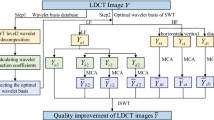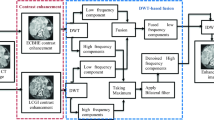Abstract
The interpolation technique of computed tomography angiography (CTA) image provides the ability for 3D reconstruction, as well as reduces the detect cost and the amount of radiation. However, most of the image interpolation algorithms cannot take the automation and accuracy into account. This study provides a new edge matching interpolation algorithm based on wavelet decomposition of CTA. It includes mark, scale and calculation (MSC). Combining the real clinical image data, this study mainly introduces how to search for proportional factor and use the root mean square operator to find a mean value. Furthermore, we re- synthesize the high frequency and low frequency parts of the processed image by wavelet inverse operation, and get the final interpolation image. MSC can make up for the shortage of the conventional Computed Tomography (CT) and Magnetic Resonance Imaging(MRI) examination. The radiation absorption and the time to check through the proposed synthesized image were significantly reduced. In clinical application, it can help doctor to find hidden lesions in time. Simultaneously, the patients get less economic burden as well as less radiation exposure absorbed.








Similar content being viewed by others
References
Li, D., Mao, S., Flores, F., et al., Dual standard reference values of left ventricular volumetric parameters by cardiac CT angiography. J. Am. Coll. Cardiol. 59(13):E1362, 2012.
Grevera, G.J., and Udupa, J.K., Shape-based interpolation of multidimensional grey-level images. IEEE Trans. Med. Imaging. 15(6):881–892, 1996.
Grevera, G.J., and Udupa, J.K., An objective comparison of 3-D image interpolation methods. IEEE Trans. Med. Imaging. 17(4):642–652, 1998.
Grevera, G.J., and Udupa, J.K., A task-specific evaluation of three-dimensional image interpolation techniques. IEEE Trans. Med. Imaging. 18(2):137–143, 1999.
Chen, J., and Ma, W., A novel adaptive 3D medical image interpolation method based on shape. Int. Conf. Graph. Image Process. 8768:876823–876821, 2013.
Yue, Z., and Jiaxin, C., Medical image interpolation algorithm based on correlation. Comput. Meas. Control. 22(9):2918–2921, 2014.
Osareh, A., and Shadgar, B., A segmentation method of lung cavities using region aided geometric snakes. J. Med. Syst. 34(34):419–433, 2010.
Yoon, S.W., Lee, C., Jin, K.K., et al., Wavelet-based multi-resolution deformation for medical endoscopic image segmentation. J. Med. Syst. 32(3):207–214, 2008.
Kass, M., Witkin, A., and Terzopoulos, D., Snakes: active contour models. Int. J. Comput. Vis. 1(4):321–331, 1988.
Zheng, Y., Li, G., and Sun, X.H., A new external force for snakes based on the IGGVF[C]// image and signal processing. CISP '08. Congress IEEE. 2008:615–619, 2008.
Wang, X., and Fu, W., Optimized SIFT image matching algorithm[C]// automation and logistics. ICAL 2008. IEEE Int. Conf. IEEE. 2008:843–847, 2008.
Daliri, M.R., Automated diagnosis of Alzheimer disease using the scale-invariant feature transforms in magnetic resonance images. J. Med. Syst. 36(2):995–1000, 2011.
Mantos, P.L.K., and Maglogiannis, I., Sensitive patient data hiding using a ROI reversible steganography scheme for DICOM images. J. Med. Syst. 40(6):1–17, 2016.
Haleem, M.S., Han, L., van Hemert, J., et al., Regional image features model for automatic classification between normal and glaucoma in fundus and scanning laser ophthalmoscopy (SLO) images. J. Med. Syst. 40(6):1–19, 2016.
Morlet, J., Arens, G., Forgeau, I., et al., Wave propagation and sampling theory. Geophysics. 47(2):222–236, 1982.
Daubechies, B. I., Orthogonal basesofcompactly supported wavelets[C]// Comm. Pure Appl. Math. 2010.
McInerney, T., and Terzopoulos, D., Deformable models in medical image analysis: a survey. Med. Image Anal. 1(2):99–108, 1996.
Lepik, U., Numerical solution of evolution equations by the Haar wavelet method. Appl. Math. Comput. 185(1):695–704, 2007.
Lai, Y.K., and Kuo, C.C.J., A Haar wavelet approach to compressed image quality measurement. J. Vis. Commun. Image Represent. 11(1):17–40, 2000.
Shen, T., and Zhang, Z.G., Edge detection of microcirculation images using snake model. J. Phys. Chem. B. 105(47):11849–11853, 2002.
Zhicheng, F. U., Xiaoqiang, L. I., University S, et al., Tongue image segmentation based on snake model and radial edge detection. J. Image Graph. 2009.
Li, T., Yi, Z., Zhi, L., and Dongcheng, H., An overview on snakes models. Comput. Eng. 31(9):1–3, 2005.
Bresson, X., Esedoḡlu, S., Vandergheynst, P., et al., Fast global minimization of the active contour/snake model. J. Math. Imaging Vision. 28(2):151–167, 2007.
Acknowledgments
This work was also supported by Research on the interative oversized screen modern film display technique (n.13-a303-15-w23). This work was also supported by Integration Demonstration of key digital medical technologies (No.2012AA02A612). National High Technology Research and Development Program (863 program).
Author information
Authors and Affiliations
Corresponding author
Additional information
This article is part of the Topical Collection on Education & Training
Rights and permissions
About this article
Cite this article
Li, Z., Chen, Y., Zhao, Y. et al. A New Method for Computed Tomography Angiography (CTA) Imaging via Wavelet Decomposition-Dependented Edge Matching Interpolation. J Med Syst 40, 184 (2016). https://doi.org/10.1007/s10916-016-0540-3
Received:
Accepted:
Published:
DOI: https://doi.org/10.1007/s10916-016-0540-3




